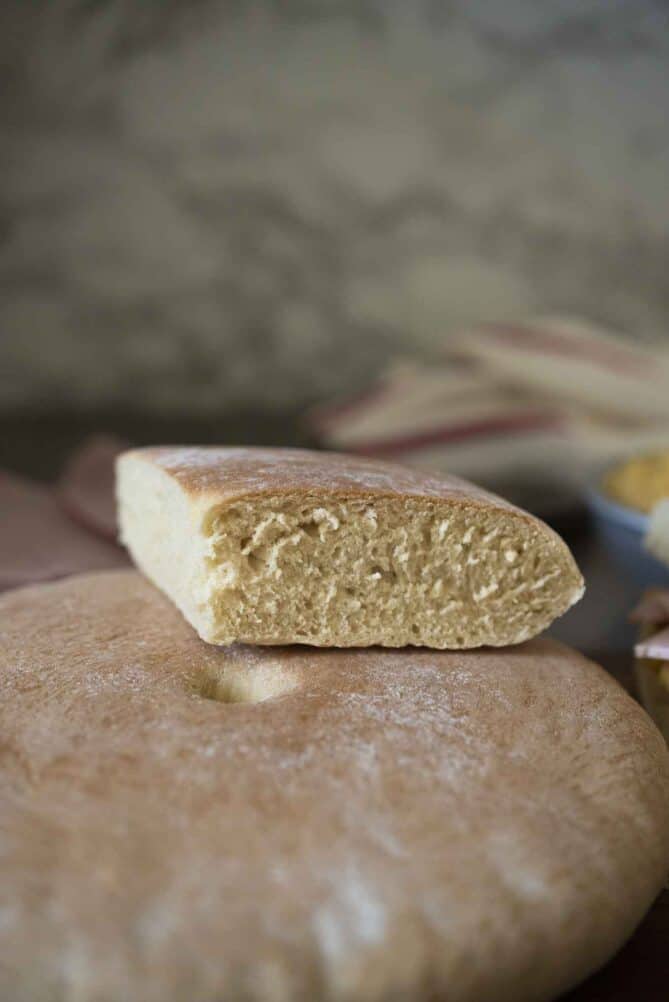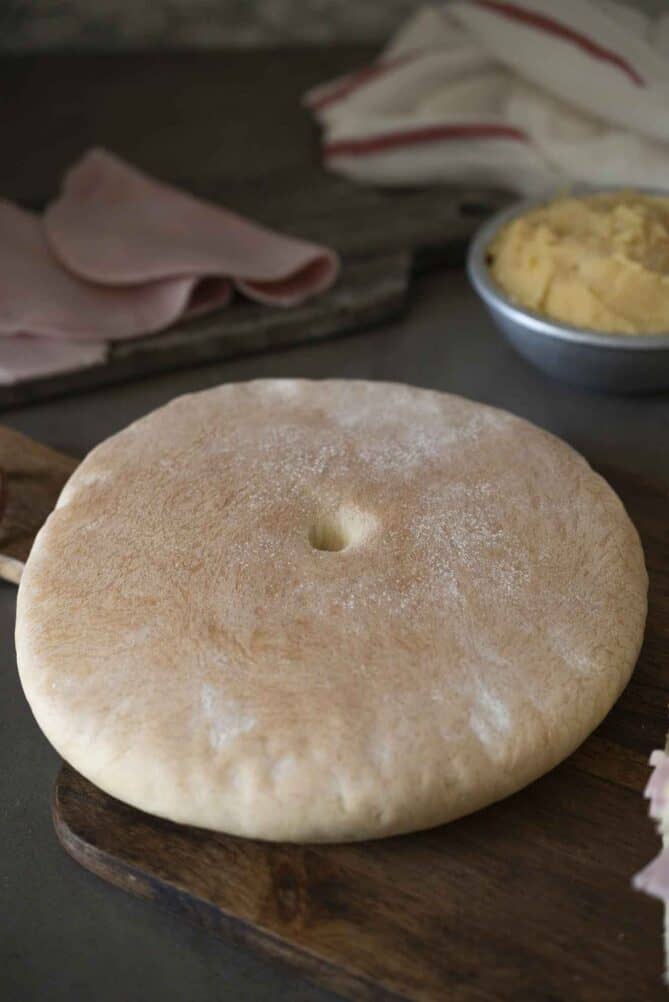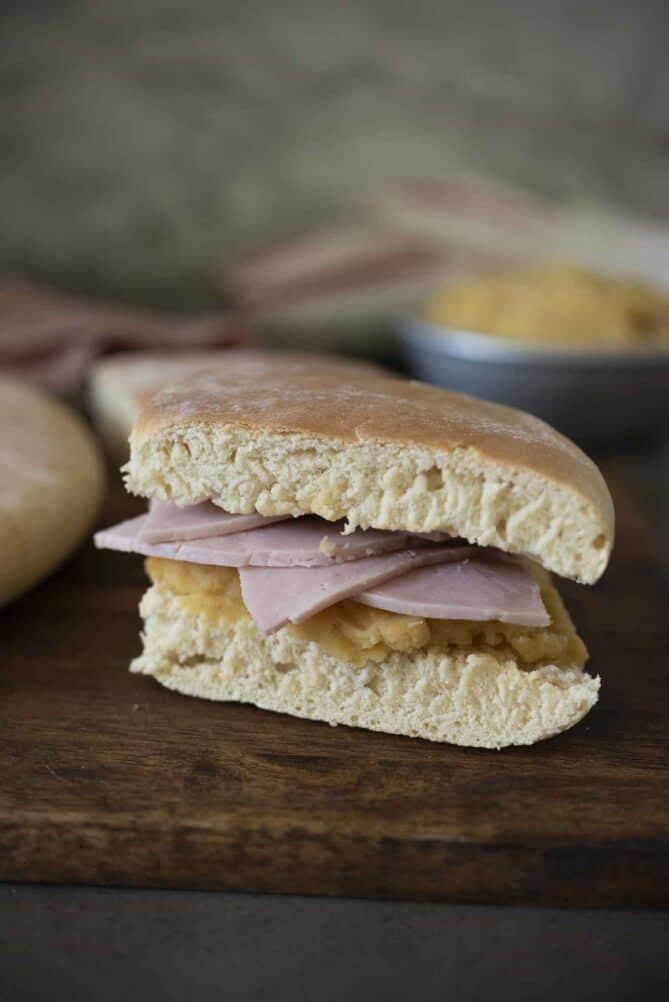Traditional Stottie Recipe
This is a Traditional Stottie Recipe which is a simple, round, flat, yeasty bread loaf with a distinct indent in the center. An iconic part of the culinary heritage of the North East of England that’s usually used for sandwiches, but is also perfect served warm with a little butter.

There are a few dishes that are very nostalgic for those of us from the North of England. Minced Beef and Dumplings, Pease Pudding and this Stottie. In typical British fashion, this bread comes with a few names: Stottie, Stotty and Stotty Cake.
A lot of slang is used in the North East of England and that’s how this bread gets its name. “Geordie” (jór-dee) is the name of the slang spoken in Newcastle. Stottie comes from the slang word to ‘Stot’ or ‘to bounce’. It is said that because they used to make the loaves so heavy and dense, if you drop them they would just bounce! Amazing.
This classic recipe is how mothers and grandmothers (including my own) have made Stotties in the North of England for 50 years. The round loaf of bread is typically cut into 4 triangle pieces then sliced in half lengthwise to enjoy simply with butter, as a side dish to a meal or used as the bread in a sandwich.

Stottie Cake History
Originating from Newcastle in the North East of England (not far from my home city) and first published in the Daily Mirror in 1949, with no recipe. They quite simply said: just roll bread dough out until it is 2.5 cm (1-inch) thick, then make a dimple in the center and bake. Clearly they figured it’s that easy to make! And it is.
If you’ve ever been to England, you’ve probably seen a bakery chain called ‘Greggs’. They’ve been making Stottie’s for almost 50 years. They stopped in 2015 only to recently return to making and selling Stottie due to popular demand and simply to revive the age old tradition.
There are other cities around the U.K. that have similar recipes. They’re called ‘Oven Cakes”, which are bread cakes or oven bottom cakes because they are baked in the lower bottom of the oven.
This is a 2 rise (proof) bread. The first rise will double in size. Then the 2nd rise will not yield much volume due to it being rolled out flat, and this is what you want. You don’t want it too risen – as it must keep its distinctive flat shape.
This recipe yields 2 large Stotties measuring 8-inches (20 cm) round. You can also make 4 smaller ones.

How do you serve Stottie?
Stottie makes great sandwich bread that is cut into triangles. It’s most popularly served with ham and pease pudding (yellow split pea puree, picture above). Or, you can enjoy the freshly baked bread simply buttered and served on the side of a meal. And one of my favorites is to use it for mopping up the gravy from Bangers and Mash with Onion Gravy. A serious treat, right there.
More Traditional British Recipes:
- Traditional Scotch Eggs
- British Cheese and Onion Pasty
- Traditional British Bread and Butter Pudding
- British Steak and Ale Pie
Traditional Stottie Recipe

A round flat yeast bread from the North East of England.
Ingredients
- ½ cup ( 150 ml) whole/full milk 105-110°F/40-43°C
- ½ cup (150 ml) water, warmed to 105-110°F/40-43°C
- 1 teaspoon granulated sugar
- 1 tablespoon vegetable oil
- 2 teaspoons (8 grams) dry, fast acting instant yeast
- 16 ounces (453 grams) bread flour/strong flour * see note
- 1 teaspoon salt
Instructions
- To a large mixing bowl, add the milk, water, sugar, oil and yeast; mix well. Sprinkle the yeast on top and leave to dissolve. Once dissolved, stir to combine and leave for 10 minutes.
- To the yeast mix, add half the flour and stir to combine. Stir in the rest of the flour and the salt. Mix until all the liquid is incorporated into the flour. Turn out onto your surface (it may be crumbly) and start kneading to incorporate the flour (don’t add more flour). Knead the dough for at least 8 minutes until it is smooth.
- Clean out the mixing bowl and rub with a little oil and place the kneaded dough inside. Cover the bowl tightly with plastic wrap and let rise at room temperature (in a warm draft free area) for about 1 hour until doubled in size.
- Once the dough has doubled in size, punch it down to expel the gas and turn out onto your surface. There should be no need to add flour, you want it soft and smooth.
- Cut the dough in half and form into flat rounds using your hands and a rolling pin, about 8-inches (20 cm). Place on a lightly oiled baking sheet, cover and let sit for 10 minutes.
- Preheat oven to 350°F/180°C and place the rack in the lower 3rd of the oven.
- Use your finger to push a dimple into the center (all the way to the bottom). Some people also poke holes all over the top with a fork (you can do one, both or neither) and sprinkle a very light coating of flour over the loaf.
- Bake for 8 minutes, then rotate the pan 180 degrees and bake for a further 6-8 minutes until lightly golden on top. Please remember: the time may vary depending on your oven.
- When done, remove and place on a cooling rack to cool. Cover lightly with a towel, this will help keep the steam in and keep the bread moist as it cools.
Notes
* Flour is more accurate when weighed, this is approximately 3 5/8 cups
Nutrition Information
Yield
8Serving Size
1Amount Per Serving Calories 234Total Fat 3gSaturated Fat 1gTrans Fat 0gUnsaturated Fat 2gCholesterol 2mgSodium 273mgCarbohydrates 43gFiber 2gSugar 1gProtein 8g
This nutrition calculation is provided by Nutronix that is only a guideline and not intended for any particular diet.


2 Comments on “Traditional Stottie Recipe”
Hi Janette,
Thank you so much for the Stottie recipe, I contacted you a while ago to ask you if you had the recipe for Stottie cake and I really appreciate the time you have taken to provide it. I can’t wait to try making it along with your pease pudding recipe, the final outcome will be like taking a visit back to Newcastle, my home town from so long ago.
You’re so welcome! I hope the recipes bring back some good memories for you.